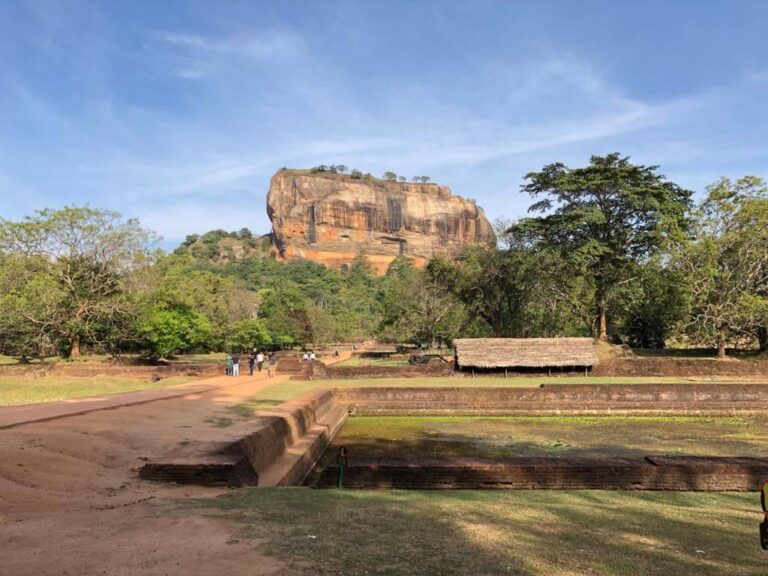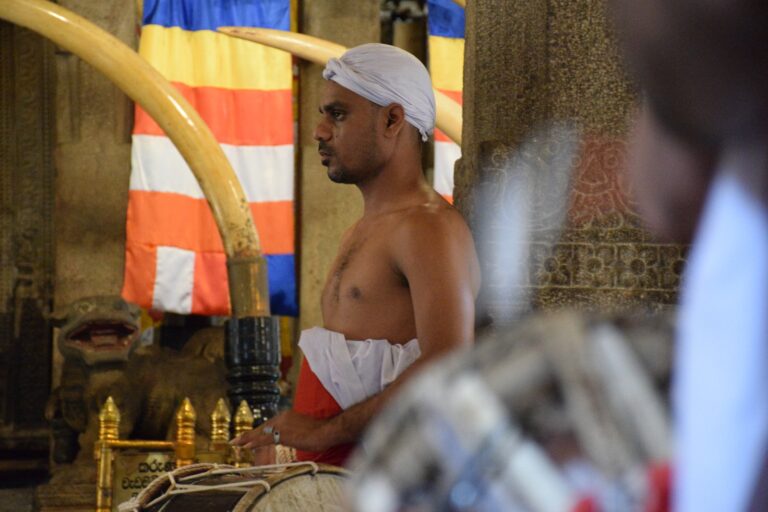History
The sacred city of Kandy was declared a World Heritage Site by UNESCO organization as living heritage city. There are 32 intact buildings belongs to colonial era of Kandy. Earlier Senkadagalapura which called Kandy had been the Medieval Royal City of Sri Lanka. Kandy also called Maha Nuwara (Great City) is officially designated as the “Cultural Capital of Sri Lanka” in spite of the undying glories of the ancient cities of Anuradhapura and Polonnaruwa. Kandy city is away from 116km west of Colombo and altitude is 500 meters. Kandy is one of the most scenic cities in Sri Lanka and the Capital of the Central Province. Kandy is an unbeatable natural fortress secured by rings of mountains and River Mahaweli the longest river in Sri Lanka. The location was geographically important for defense strategy of the Kandy Kingdom.
The mountainous terrain, greenery, Mediterranean climate and lush green mountain peaks are also the gateway to the Central Highlands of Sri Lanka. Kandy is the proud & last bastion of an independent Sinhalese tradition which preserved its freedom through two & half centuries. Ancient palace complex, Buddhist and Hindu Shrines and colonial buildings give it a special character while religious importance of the sacred Tooth Relic of the Buddha and annual procession contribute unique cultural endemism to the historic hill capital.
History of Kandy
Kandy was last Royal capital of Sri Lanka during the period of 1469-1815 A.D and original name was “Kanda Uda Pas Rata”. The shrine dedicated to god Natha in Senkadagalapura is the oldest existing structure in Kandy which was built in Gampola period of 1357 – 1374 A.D. According to the historical record of “Asgiri Thalpatha”, in the first quarter of 14th century established a city named Senkadagala Siriwardhanapura and it is the first establishment of Kandy city.
There were 12kings (Eight Sinhala Kings and four South Indian Kings) ruled Kandy within 130 years. Kandy has played a major role in Sri Lankan history not only as last capital but also the last bastion of Sinhalese culture rooted more than two thousand years. Unique traditional values, arts, architecture and literature with long tradition patronage ended in Kandy with handing over the Kingdom under the written agreement by the south Indian kings to the British in 1815 and they occupied 133 years in Sri Lanka.
Sacred Tooth Relic & Tooth relic temple
The sacred Tooth Relic of Loard Buddha brought to Sri Lanka by Prince Dantha and Princess Hemamala during the region of King Keerthi Sri Meghawarna on 301 A.D. – 328 A.D. This was referred as the palladium of the Sinhalese royalty and the emblem of kingship. It was granted the royal patronage to protect and venerated by the Sinhalese king with building a temple. Until the region of King Wimaladharmasuriya (1592- 1604 A.D), the sacred tooth relic was preserved in a specially constructed palace complex which was decorated with Sinhalese architectural patterns.
4th Century A.D King Kithsirimewan enshrined Sacred Tooth Relic in a pure crystal bowl and built a temple named Dhammachakka Mandira in inner citadel of Anuradhapura. Since it was rightful here to the throne it was never enshrined in a Stupa and shifted from place to place when kingdom was shifted. When collapsing Anuradhapura kingdom Sacred Tooth Relic also shifted to Polonnaruwa kingdom.
With the starting of Polonnaruwa kingdom in 11th century A.D, King Vijayabahu the great brought Sacred Tooth Relic to “Atadaageya” in sacred quadrangle in Polonnaruwa. It was second Sacred Tooth Relic temple. There are another two temples built for the sake of Sacred Tooth Relic named “Watadageya” and “Hetadageya” in Polonnaruwa.
With the south Indian invasions in 1215 A.D Sacred Tooth Relic was carried to Kothmale in central part of Sri Lanka. With this South Indian invasions kingdom was collapsed and Sacred Tooth Relic shifted to Beligala Temple in Kegalle and Kingdom of Sri Lanka was shifted to Dambadeniya in 1232 A.D. Tooth Relic Was Brought to Dambadeniya in 1236 A.D. In 1272 A.D Yapahuwa was selected as kingdom and Tooth Relic temple transferred to Yaapahuwa Kingdom. In 1284 A.D Again South Indian invader invaded Yapahuwa and he took away the Tooth Relic to India. King Parakramabahu III persuade South Indian King and brought back to Polonnaruwa again and placed there. In 1302 A.D King Parakramabahu IV placed tooth relic his capital Kurunegala.
A three storied building was built by King Parakramabahu VI in Kotte and Tooth relic Placed there in the year of 1412 A.D.. King Wimaladharmasuriya came to the throne in Kandiyan kingdom and he constructed a temple for Sacred Tooth Relic in 1592 A.D.. Before Sacred Tooth Relic brought to Kandy, it was hidden in the temple of Delgamuwa in Sabaragamuwa Province. In 1815 A.D British came to the power in Sri Lanka and they have been taken Sacred Tooth Relic in to their custody. During the rebellion in 1818 the Sacred Tooth Relic was hidden in a forest. British controlled the upheaval and they were able to find the tooth relic and brought back to Kandy with taking in to their custody. In 1853 A.D. the sacred Tooth Relic was handed over to Lay custodian (Diyawadana Nilame) and chief incumbents of Malwatte and Asgiriya Monastries in Kandy.
The most important place of Kandy World heritage city is Sacred Tooth Relic Temple premises. It was originally built by King Wimaladharmasuriya in 1592 – 1603 A.D. King Wimaladharmasuriya II again built three storied building for Sacred Tooth Relic Temple. Later on Portuguese and Dutch were invaded Kandy and destroyed these two buildings and finally the two storied building that we can see now a days was built by last Sinhala King Sri Weera Parakrmama Narendrasinghe with his period of 1707 – 1739 A.D. But this building also faced an invasions of Dutch and later on King Keerthi Sri Rajasinghe (1747 – 1781 A.D) renovated it to present condition.
The octagonal building and the moat was latterly added by Last Sri Lankan King Sri Wickrama Rajasinghe (1798 – 1815) for the adornment of the Sacred Tooth Relic Temple and it was designed by architecture Devendra Moolachari who came from South India. At present this building is an oriental library which exhibits ancient books including “Ola Leaf” collection of ancient Sinhalese. But earlier it was used to address their people by king. Along the moat run there are two brick walls. The wall which comes first called as “Walakulu Bemma” the cloud drift wall and inner wall Known as “Diya Reli Bemma” ripples wave or water ripple wall. The main entrance to the Sacred Tooth relic temple called as “Maha Whalkada” and it is a bridge over the moat.
There is a traditional entrance with Kandiyan style before entering to Maha Wahalkada and net there is a dragon arch “Makara Thorana” and passes through a tunnel named “Ambaraawa” and reach to Drummers Hall “ Hevisi Mandapaya”. After reaching drummers hall there is a two storied building which called inner sanctum “Wedasitina Maligawa”. The lower chamber of this building called “Palle Male” and the upper chamber called as “Uda Male or Wedasitina Maligawa”. Before entering to the octagonal building there is an image house from the right side. Reaching with second floor there are three rooms inside there. First two are called “Handun Koonama” sandalwood shed and “Gandhakuti” or a Perfumed chamber. The third room is the place which the Sacred Tooth Relic take placed called “Wedasitina Maligawa” or inner sanctum. There are gem studded seven golden caskets enclosing the sacred Tooth Relic. The outermost casket is embellishment with jewelries.
Kandy Esala Pageant
Kandy Esala Pageant display highlight the great value of the Sinhalese culture and it is held annually in the months of July/August and the days for pageant is fixed with an auspicious days and times. The Kandy Pageant gives the opportunity to witness the unique talents and skills of the Lankan dancers, musicians, jugglers, fire breathers, acrobats and other various performers, lavishly decorated tuskres with elephants accompany the pageant, therefore this event represent the most colorful religious and cultural events in not only Sri Lanka but also South Asia.
Chinese pilgrim, Fa Hien, who visited Sri Lanka in the fifth century AD. According to the eye-witness account of Fa Hien Sacred Tooth Relic was carried in procession along the roads to Abhayagiri vihara in Anuradhapura. According to the Sinhala chronicle ‘Dāladā Siritā, (Rituals of the Sacred Tooth relic) written in the fourteenth century, enumerates the rules and regulations pertaining to the maintenance of the sacred relic, and according to it. Tooth relic festivals should be performed annually to obtain rain.
The origins of the “Dalada Perahera” Pageant of The Sacred Tooth Relic date back to the time of King Kirthi Sri Meghavanna who received the Sacred Tooth Relic of the Buddha, brought from India by Princess Hemamala and Prince Danta, during his reign in Anuradhapura in 4th Century A.D. The king ordered that the Sacred Tooth Relic be taken around the Anuradhapura city once a year with pomp and pageantry.
During the region of King Kirti Sri Rajasinha in Kandy, the Pageant of the Sacred Tooth Relic Temple joined with the four “Devala perahera” shrines pageant of the Natha, Vishnu, Kataragama and Pattini on a request made to the king by Maha Thera Upali from “Siam” Thailand who came to revive Upasampada (higher ordination).
Kandy Esala Perahare is a combination of two processions of Esala and Dalada. The Esala pageant was an old ritual performed to request for rain from the Gods to continue their agricultural activities and this ritual is still performed at the Kandy perahara. Dalada perahara is performed to pay homage to the sacred tooth relic of Lord Buddha, which was secured at the Sri Dalada Maligawa (Tooth temple) back in the 4th century A.D.
The firstever ceremony of the Esala perahera is the ‘Kap’ situweema (planting of the Kapa) in the premises of the four “Devalas”shrine premises. They select and prepare a young jak tree, which must have borne no fruit and plant in the ground at an auspicious time (nakata), in a special place decorated with leaves, flowers, and fruits. When cut, this jack tree exudes a white sap which is regarded as a symbol of prosperity and the trunk is divided into four, one for each shrines.
Ending with this auspicious event, in the next five nights’ small processions “Devala Prahera”are held within the shrine precincts. In the 6th night start “Kumbal Perahera” which come outside from four Shrine premises to join procession of Sacred Tooth Relic Temple’s procession and goes around the city for another 5 nights. The night which comes from 11th day start a grand procession for another five nights called “Randoli Prahera” and it finishes the Full Moon day of August “Nikini Full Moon Day”. Each night procession is become grander and the grandest procession is held in the Full moon day which comes in month of August. The last day of procession is held on day time for water cutting ceremony and records the end of Sacred tooth relic pageant and Esala Pageant.
The whole festival comes to the end when following afternoon the Sacred Tooth Relic Temple pageant returns to the tooth relic temple from the “Adhanamaluwa Vihara bringing back the golden casket.



